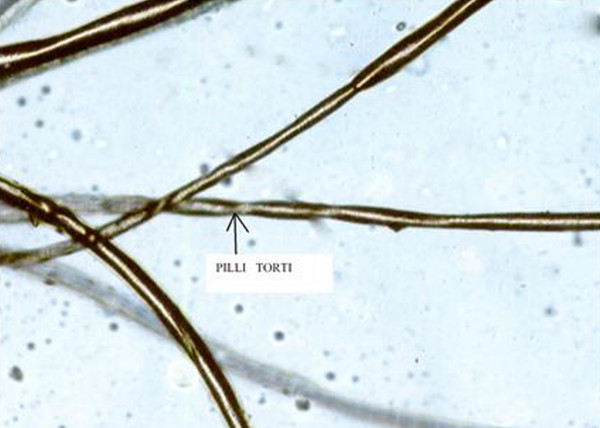Menkes disease (MNK), also called Menkes syndrome, copper transport disease, steely hair disease, kinky hair disease, or Menkes kinky hair syndrome, is a disorder that affects copper levels in the body, leading to copper deficiency. It is an x-linked recessive disorder, and is therefore considerably more common in males: females require two defective alleles to develop the disease.
The disorder was originally described by John Hans Menkes (1928â€"2008) et al. in 1962.
Characteristics

MNK is characterized by growth failure, and deterioration of the nervous system. Onset of Menkes syndrome typically begins during infancy. Signs and symptoms of this disorder include weak muscle tone (hypotonia), sagging facial features, seizures, intellectual disability, blue sclera and developmental delay. The patients have brittle hair and metaphyseal widening. In rare cases, symptoms begin later in childhood and are less severe. Affected infants may be born prematurely. Symptoms appear during infancy and are largely a result of abnormal intestinal copper absorption with secondary deficiency in copper-dependent mitochondrial enzymes. Normal or slightly slowed development may proceed for 2 to 3 months, and then there will be severe developmental delay and a loss of early developmental skills. Menkes Disease is also characterized by seizures, failure to thrive, subnormal body temperature, and strikingly peculiar hair, which is kinky, colorless or steel-colored, and easily broken. There can be extensive neurodegeneration in the gray matter of the brain. Arteries in the brain can also be twisted with frayed and split inner walls. This can lead to rupture or blockage of the arteries. Weakened bones (osteoporosis) may result in fractures.
Occipital horn syndrome (sometimes called X-linked cutis laxa or Ehlers-Danlos type 9) is a mild form of Menkes syndrome that begins in early to middle childhood. It is characterized by calcium deposits in a bone at the base of the skull (occipital bone), coarse hair, and loose skin and joints.
Cause and genetics

Mutations in the ATP7A gene, located on chromosome Xq21.1, are the cause of Menkes syndrome. This condition is inherited in an X-linked recessive pattern. As the result of a mutation in the ATP7A gene, copper is poorly distributed to cells in the body. Copper accumulates in some tissues, such as the small intestine and kidneys, while the brain and other tissues have unusually low levels. The decreased supply of copper can reduce the activity of numerous copper-containing enzymes that are necessary for the structure and function of bone, skin, hair, blood vessels and the nervous system such as lysyl oxidase.
Diagnosis and treatment

Urine homovanillic acid/vanillylmandelic acid ratio has been proposed as a screening tool to support earlier detection. Early treatment with subcutaneous (under the skin) or intravenous (in a vein) injections of copper supplements (in the form of acetate salts) may be of some benefit. Other treatment is symptomatic and supportive.
Epidemiology
-Mouse-Model-for-Menkes-Disease-with-Copper-Combined-pone.0040400.s010.ogv/320px--Prenatal-Treatment-of-Mosaic-Mice-(Atp7a-mo-ms)-Mouse-Model-for-Menkes-Disease-with-Copper-Combined-pone.0040400.s010.ogv.jpg)
One European study reported a rate of 1 in 254,000; a Japanese study reported a rate of 1 in 357,143.

